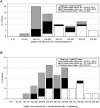Worse breast cancer prognosis of BRCA1/BRCA2 mutation carriers: what's the evidence? A systematic review with meta-analysis
- PMID: 25816289
- PMCID: PMC4376645
- DOI: 10.1371/journal.pone.0120189
Worse breast cancer prognosis of BRCA1/BRCA2 mutation carriers: what's the evidence? A systematic review with meta-analysis
Abstract
Objective: Conflicting conclusions have been published regarding breast cancer survival of BRCA1/2 mutation carriers. Here we provide an evidence-based systematic literature review.
Methods: Eligible publications were observational studies assessing the survival of breast cancer patients carrying a BRCA1/2 mutation compared to non-carriers or the general breast cancer population. We performed meta-analyses and best-evidence syntheses for survival outcomes taking into account study quality assessed by selection bias, misclassification bias and confounding.
Results: Sixty-six relevant studies were identified. Moderate evidence for a worse unadjusted recurrence-free survival for BRCA1 mutation carriers was found. For BRCA1 and BRCA2 there was a tendency towards a worse breast cancer-specific and overall survival, however, results were heterogeneous and the evidence was judged to be indecisive. Surprisingly, only 8 studies considered adjuvant treatment as a confounder or effect modifier while only two studies took prophylactic surgery into account. Adjustment for tumour characteristics tended to shift the observed risk estimates towards a relatively more favourable survival.
Conclusions: In contrast to currently held beliefs of some oncologists, current evidence does not support worse breast cancer survival of BRCA1/2 mutation carriers in the adjuvant setting; differences if any are likely to be small. More well-designed studies are awaited.
Conflict of interest statement
Figures




References
-
- Robson ME. Clinical considerations in the management of individuals at risk for hereditary breast and ovarian cancer. Cancer Control. 2002;9: 457–465. - PubMed
-
- Honrado E, Osorio A, Palacios J, Benitez J. Pathology and gene expression of hereditary breast tumors associated with BRCA1, BRCA2 and CHEK2 gene mutations. Oncogene. 2006;25: 5837–5845. - PubMed
-
- Phillips KA. Current perspectives on BRCA1- and BRCA2-associated breast cancers. Intern Med J. 2001;31: 349–356. - PubMed
-
- Narod SA, Foulkes WD. BRCA1 and BRCA2: 1994 and beyond. Nat Rev Cancer. 2004;4: 665–676. - PubMed
-
- Porter DE, Cohen BB, Wallace MR, Smyth E, Chetty U, Dixon JM, et al. Breast cancer incidence, penetrance and survival in probable carriers of BRCA1 gene mutation in families linked to BRCA1 on chromosome 17q12–21. Br J Surg. 1994;81: 1512–1515. - PubMed
Publication types
MeSH terms
Substances
LinkOut - more resources
Full Text Sources
Other Literature Sources
Medical
Miscellaneous

